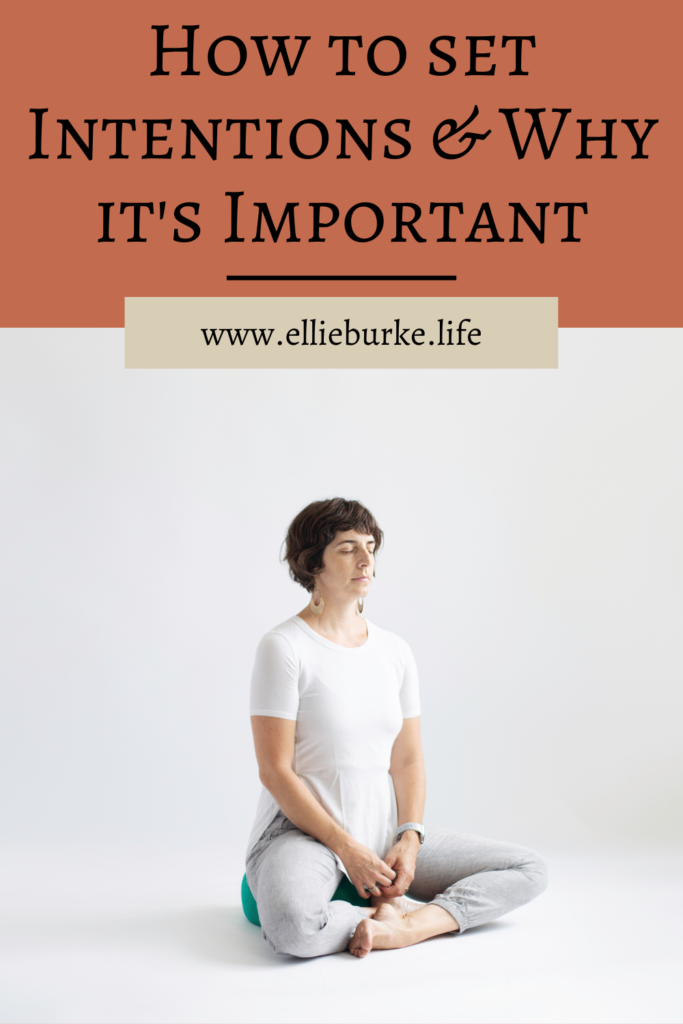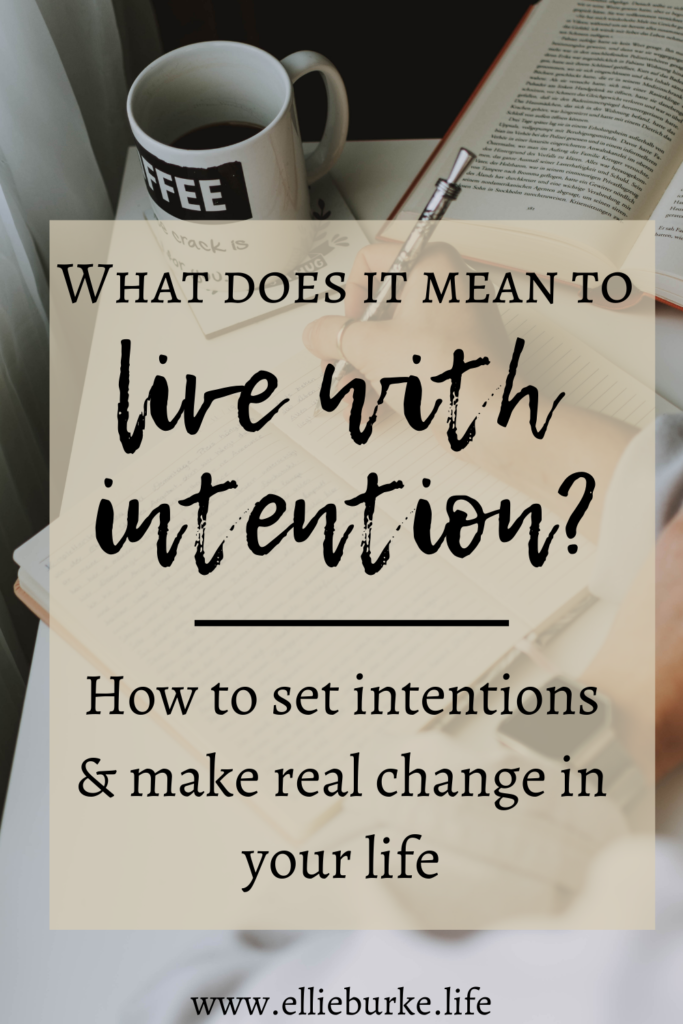Ellie Burke
How to Set Intentions & Why It’s Important

in·ten·tion
inˈten(t)SH(ə)n/
noun
- a thing intended; an aim or plan.
If you, like me, are involved in the world of mindfulness, yoga, meditation, coaching, etc. Then you, like me, hear it all the time:
“What’s your intention?”
“Set an intention.”
“Be intentional.”
So, what does “intention” actually mean? And why do we do it?
In this post, we will walk through how to set intentions, what that really means and why it’s important. But first, a little story on my journey with intention that I think sheds light on the deeper understanding of how to set intentions and why it’s so important to live intentionally.
What is Intention, an Anecdote
I remember, as a newbie yoga practitioner, being introduced to this idea that I could set an intention and “work” on that intention via my yoga practice. And that those qualities would seamlessly integrate into my life, somehow. I just chalked it up to all those mystical, mysterious effects of yoga.
At the time, I was working, full-time, on my Master’s degree in Special Education, while student-teaching, full-time, in a middle school for children with special needs. Almost daily, as I stepped onto my yoga mat, my intention would be to cultivate patience. I believed that what I needed most was patience with the children and their various learning processes. And I would practice that patience by choosing patience in my yoga practice when I felt I was becoming impatient.
I often only saw impatience arise when I faced challenging balancing postures, inversions or deep backbends. You know, the fancy ones. {Side note: looking back, and chuckling to myself, I see now that even more important than cultivating patience with what I deemed to be challenging to me externally was patience with myself, with my own process, and with life, itself; forget the “advanced” poses, my greatest “work” showed up in the simplest of shapes and in the most uncomplicated moments that I had been bypassing in my striving}.
But what I didn’t realize was that the ancient yogis weren’t mystical, mysterious, or magical. They were exceptionally practical. They lived with a determined attention, a willingness to stay attuned to themselves not just in their physical practice, but in their daily actions, in how they were showing up in the world.
This way of living was explored in and supported by their asana, pranayama, and meditation practices. Intention didn’t exist in a silo and it certainly didn’t come to fruition without attentive action, conscious choice. We can’t expect that being intentional in our yoga practice will automatically keep us awake and intentional in our lives.
The Intention Myth
Intention doesn’t come to life if we toss it like a coin into a fountain or “think it” as we blow out the birthday candles. We have to approach our lives as we do our practice – with attention. (Enter one of my favorite phrases: how we do anything is how we do everything).
When we set an intention, we make a conscious choice. We are choosing to actively and attentively choose, moment by moment, how to be in relationship with life — all of life. This is absolutely not passive or inactive. And it certainly isn’t based in illusion. We’re talking about real life, real time, real pain, real struggle, real choice.
Why it’s important to set intentions
Setting an intention or intentions for the day/month/year puts purpose behind everything you do. It directs your thoughts and actions toward what you want to achieve or hope to attract into your life. Without it, the day can go by feeling empty, unproductive or uneventful. When we are looking to change our lives or change them even in some small way, setting intentions each day can help to get us there. Without them it’s like riding a bike with no direction.
This can bring us back to the idea of motion vs action. James Clear describes “motion” as expending energy that doesn’t get us to our goal where “action” is expending energy that does get us to our goal. A day without intention is a day in motion. We go about our day without focus and often just let things happen as they will. Add intention to that and you have a day in action. A day consisting of steps toward something new, a change, a goal.
So, ask yourself: What do I need right now? What would be supportive in my life, from an internal perspective? And am I willing to consciously and honestly stay attuned to life and my response to it? Am I willing to remain alert so I can choose to align with that intention?
What gets in the way of intention becoming manifest?
- Habitual ways of thinking (which leads to)
- Habitual ways of feeling (which leads to)
- Habitual ways of behaving/doing (or non-doing)
And all of these things can be attributed to a lack of attention.
In other words, certain ways of thinking, feeling and behaving become a mindless habit that we just accept as our truth, our reality. When in fact, we can apply attention to these thoughts and patterns and actively shift our reality.
How to Set Intentions
So, how does intention turn into reality? How does intention become manifested? When we set an intention from a place that feels like it’s in alignment with ourselves, we must then take actions in our lives to create what it is we want. As I said, intention isn’t like making a wish and tossing a coin into a fountain. It’s about getting super clear on what it is we want and why and then working towards it.
But it’s not just a simple 2-part process. When we create an intention, we also want to look at what exists between intention and action or behavior. All of us operate, to some great degree, in habit or unconsciousness. We have habitual ways that we perceive and think about ourselves and the world which, in turn, leads to habitual ways of feeling. Those feelings then lead to habitual ways of behaving – action or inaction. And we’re right back where we started – no matter how committed to our intention we are!
What I suggest as far as how to set intentions:
1) Start with clarity of intention – what is your deeper wish in relation to the intention you are setting?
2) Cultivate a practice of attention – noticing what you are thinking, how that’s making you feel, and how that is driving your behavior (you cannot change that which you are unaware)
3) As you begin to work with your intention, remember why you are choosing what you are choosing – notice if an old, familiar thought, story, or feeling comes up and notice how it is impacting your behavior or action – is it moving you toward or away from your intention?
4) In this way, make conscious, intentional choices repeatedly and frequently throughout the course of your day/week – remembering that intentions become manifest by way of the cumulative effect of small intentional choices over time.
How to Set Intentions & Stick with them
One of the main goals when setting intentions is to become more intentional in general, to live with intention each day. This is a process of course as we are learning to live in a different way. Be patient with yourself and be sure to spend some time each day focusing on the change you want to make and why it’s important to you.
Find gratitude for the things you already have in your life. A gratitude practice allows us to focus on what we have and pull us out of a scarcity mindset that can keep us from growing and allowing the energy of our intentions to come through. It’s hard to pull new opportunities our way when we are stuck in a mindset of lack. Gratitude helps with that.
Actionable tips for staying accountable to your intentions and/or living with intention every day:
- Sit quietly with yourself every morning. This doesn’t have to be a full meditation but spend 5 minutes first thing in the morning, remembering or calling forward your intention
- Journal each morning- this could be as simple as writing down your intention for the day and elaborating on what that feels like or looks like and why it’s important to you
- Start a gratitude practice- writing down three things you are grateful for every morning is a great start – but don’t stop there! Reflect upon the list and truly FEEL the gratitude. This will open you energetically to meet life and create what you are wishing for
- When you find yourself out of alignment with your intention, that’s ok. Recognize that you are out of alignment, be compassionate with yourself and do your best to get back on track
Intentional days create a life on purpose. – Adrienne Enns
Life Coaching clients often come to me because they’re discontent or unhappy with certain feelings or behaviors/actions and they want change but feel stuck. When I work with my clients, we often work at the layer of thought (often habitual and patterned). We work to interrupt at that layer since the thought drives the feelings which drives the action. And most of the work we do at the beginning centers around developing an awareness of habitual ways of thinking; understanding, first, that this thought is powerful and, second, that we have ways to work with undoing and not believing the thought.
For more info on working with me, head to the coaching page.
with love,
Ellie
Like this post? Pin it for later!
June 19, 2021


[…] is where intentionality comes in. The word “intention” gets tossed around a lot and often ends up having the vibe of […]